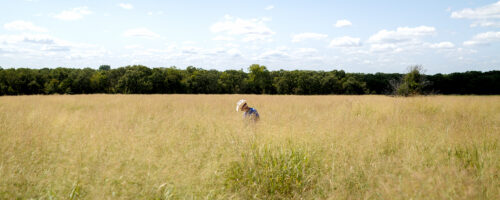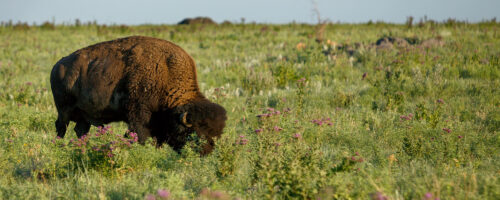How to Find Tenants Who Will Take Care of Your Soil
Shared goals and long-term mindsets make the best partnerships for regenerative management of leased land.
Whether you’re an owner-operator, tenant, or landlord, the success of regenerative management rests upon adopting a long-term mindset, Noble Research Institute livestock consultant Robert Wells says.
“It’s looking at everything you do as a lifelong journey — actually, more than lifelong,” he explains. “Everything you do on that land impacts generations down the road; our lives are just a small fraction of time.”
If you’re a non-operating landlord striving to find a tenant who will take care of your soil and practice regenerative management for the long haul, the first step is to identify the health and regeneration of the land as your No. 1 shared priority.
“If both parties keep the land as the center of their focus, and we’re both doing the right thing for the land first, then everything else will come,” Wells says.

Get into the right groups and networks, ask questions
If you’re a new landowner or simply taking a new approach to longstanding holdings, an important first step toward finding a leaseholder with shared, regenerative values is to get involved in the right networks.
“Social media is a wonderful tool to find groups with the same interests as you,” Wells says. He suggests seeking out organizations and groups — both online and at in-person conferences or gatherings — that specifically speak to a holistic or regenerative ranching audience. Join in, monitor discussions, listen, learn and participate as you can.
“This is a great way to meet potential employees or tenants, but also to keep you educated and up to date with what’s current in the field,” he says. In the course of your participation, make it known that you’re a landowner looking for a tenant who will share your values.
If you’re coming from the same discussion group or gathering, you’re more likely to start with shared ideas and vocabulary, a good basis for relational success.

Be ready with an application form
Have a tenant application form ready to share when you meet a potential leaseholder. Many county extension offices will have templates you can customize to get started with an application form.
“Most importantly, actually follow up on that application,” Wells says. “Call the references, do the background check, make sure that person has a history of ethical behavior and the experience, ability and resources they need to be successful on your land.”
Be prepared to sit down with your potential leaseholder and ask a lot of questions. Ask about their capacity, how many other leases they hold or how much other property they manage, and how they’ve marked progress on other land. Do they have other people working for them? If so, learn more about their hired help as well as business partners.

Know what you’ve got and where you want it to go
Once you’ve selected a potential leaseholder, help create a shared understanding of your land’s baseline and potential. Sharing historic and current biological soil test results, forage tests and/or data from monitoring transects with your new leaseholder will give you a strong foundation to build regenerative goals upon.
“Consider having a county extension agent or NRCS advisor come out to do some pasture assessments to give you a third-party estimate on what the land’s capacity is,” Wells says. Having current and accurate maps of your land — available through Google Earth or services like the USDA’s Web Soil Survey — can also help identify and plan out management tactics and goals.
“Having that information upfront will help you and your tenant see the direction you want to take that land,” Wells says. Then, you can set goals together and look for ways the leaseholder’s management can contribute to moving the needle toward those objectives.

Work toward long-term wins
Regenerative management often appeals to stewards who want to work with nature instead of against it. Successful regenerative relationships call for similar collaboration.
“Both the landlord and the tenant have to remember that both sides are in this as a business,” Wells says.
It’s natural for each party to try to attain the best deal for themselves in a lease negotiation, but at the end of the day, there’s no room for micro-management. Consider yourself partners with the shared, long-term goal of improving your soil health.
He suggests two parameters when negotiating a lease agreement with your new partner.
First, aim for a multi-year agreement. It might be nerve-wracking to tie yourself to a long-term contract right off the bat, but nothing engenders near-sighted thinking like short-term agreements. Wells suggests not less than three years, with an aim for more.
“Tenants will be more encouraged to put the effort in to improve a lease pasture if they know they have it for a longer period of time and feel that they have a good chance of keeping it,” he says. “It is disheartening to put a lot of work into a property only to have it leased to the highest bidder next time — and have them capitalize from the hard work you have put into the property.”
Second, lease the land on an animal-unit basis. Wells suggests a lease based on an average animal-unit capacity with flexibility to ‘float’ that number between good years and bad.
That means you might agree to a 20,000 average animal unit lease over six years. If it’s dry one year, they might only stock 15,000. In a good year with more forage growth, they might move up to 25,000.
“That flexibility allows the manager to really put the land first, and you both win there,” Wells says.
“When you find a good management relationship that can last for 10, 15, 20, 50 years, even span generations, that’s when you can have the most positive impact on the land,” Wells says.
“Change really does take time, and when you get that kind of longevity, you know you’re putting your efforts into something that is going to last.”



Comment